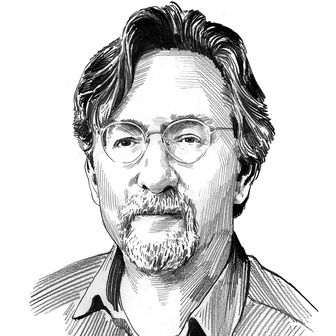Yes, yes, I know: What!? 40 Bond but no 40 Mercer? Yes to the Lipstick Building, but no to the LVMH Tower? I share your pain: Despite what people say, we just don’t live in a design-poor city. So I chose work that had major impact, upheld its ideals, and became a part of our lives. I left out most private interiors, and I chose each architect’s greatest, not largest, work. That’s why Renzo Piano’s Morgan Library made the cut and his Times Tower didn’t. And I omitted the new Pritzker winner, Jean Nouvel, because I think his best New York work is yet to come.
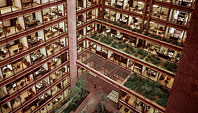
FORD FOUNDATION BUILDING, 1968
Long before green became a cause more than a color, Kevin Roche and John Dinkeloo designed a corporate terrarium that oxygenates the office air. Employees look in, not out, on nature: The best views are of the atrium. It’s a vertical park, and one that East 42nd Street sorely needed. (Technically, it opened in December 1967, but it was the talk of ’68.)
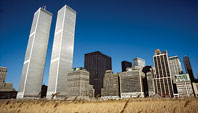
WORLD TRADE CENTER, 1973
Minoru Yamasaki’s Twin Towers seemed to have stepped on the city rather than grown out of it, but in their defiant bulk they did represent New York swagger. Even the holes they left, in the sky and in the ground, triggered a surge of interest in the city’s future shape.
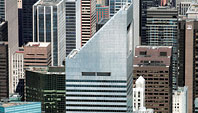
CITICORP CENTER, 1977
A pillar of brawn in a silken skin, Hugh Stubbins & Associates’ Citicorp defies a midtown skyline full of flattops with its rakish slanted roof. The tower seems to be hoisting itself into the atmosphere, an impression strengthened by the sunken plaza and the boosterlike columns at the midpoint of each side, at once powerful and dainty.
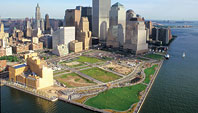
BATTERY PARK CITY, 1979 (MASTER PLAN)
Thirty years after it was planned as a brick-and-nostalgia evocation of the Upper West Side, Battery Park City has rescued the waterfront from a century’s worth of defunct docks. Sailboats launch from an adorable marina, joggers commune with harbor views, and a neighborhood built on landfill has finally, unexpectedly, acquired character.
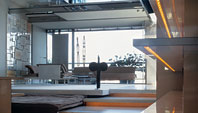
PAUL RUDOLPH PENTHOUSE, 1977–1997
Perched like an urban tree house on a block stiff with Knickerbocker gentility, Rudolph’s four-level assemblage of modern boxes and lattice-covered balconies foams over the top of a Georgian townhouse. Twenty years of his tinkering added floating planes, stairs without railings, and vertiginous openings to multistory drops; it’s a showcase for the glamorous, childless Manhattan life.
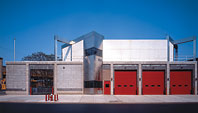
FIREHOUSE FOR ENGINE CO. 233, LADDER CO. 176, 1985
A Brooklyn cocktail, toughness topped with theory. In Peter Eisenman’s Bed-Stuy firehouse, the first floor is all no-nonsense defiance. Then the silvery upper story sweeps back at 45 degrees to the street, following the line of the nearby el and giving depth to the Mondrian grid.
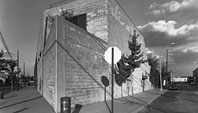
THE NOGUCHI MUSEUM, 1985
In one of those undistinguished old factory buildings that litter neighborhoods like Long Island City, the sculptor Isamu Noguchi birthed what would become a posthumous museum to himself. Outside, it looks like nothing, but the concrete floors, exposed I-beams, and rough/polished hunks of stone, bathed in milky daylight, make it a lovely postindustrial oasis.
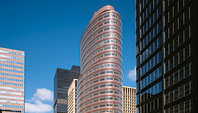
THE LIPSTICK BUILDING, 1986
Philip Johnson, that wily New York character, could make appalling errors in judgment, but this seemingly retractable tower wasn’t one of them. The oval cylinder sheathed in coral-colored stone, bearing a smaller cylinder and then another, might have been another preening postmodern gewgaw if it were in, say, Houston. On blah Third Avenue, it’s more like a reproach: Lighten up!
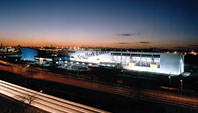
NEW YORK TIMES PRINTING PLANT, 1997
In the world’s capital of branding, even the Gray Lady plasters her name across its plant, like a giant copy of the Times hanging off the breakfast table. The paper made the switch to color late, but with gusto, installing new presses in Polshek Partnership’s billboard-building just off the Whitestone Expressway. It’s meant to make an impression at 60 miles per hour: Blocks of yellow and red jump out from a newsprint-white façade. No sober impartiality here.
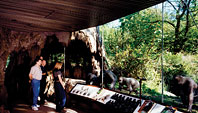
CONGO GORILLA FOREST, BRONX ZOO, 1999
What might have been an exercise in zoological kitsch—follow the winding path into a Vegas-ish miniature rain forest, complete with mist—turned instead into a way to commune at close quarters with disturbingly familiar primates. In Helpern Architects’ ape house, spectators and displays both press their cheeks against the glass, but the gorillas are the ones frolicking freely, watching the humans packed together in their dark shed.
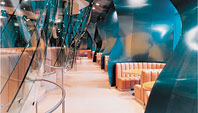
CONDÉ NAST CAFETERIA, 2000
In his first New York project, Frank Gehry grappled with a venerable publishing-industry ritual: lunch. The space fails in its literal requirements—getting hungry staff through a line, to a table, and quickly back to their desks. New Yorkers are used to jostling, only here they do it in a radiant space that appears to be in a constant state of liquefaction. By comparison, Gehry’s first freestanding building in the city, the IAC headquarters on West 19th Street, looks fussy and vague.
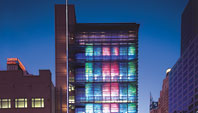
NEW 42ND STREET STUDIOS, 2000
The current incarnation of Times Square—candy colors, schlock, and all—is a colossal and coordinated achievement, not least because it was preceded by an assortment of appalling schemes. (As for those warm memories of its porn-palace days, they’re romanticizing misery.) Platt Byard Dovell’s symbol of the district’s renewal is this collection of rehearsal studios with a glass façade clad in nothing but colored lights. A luminous wand stands guard out front, announcing, This is where the action is!
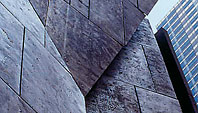
AMERICAN FOLK ART MUSEUM, 2001
You can’t touch the objects at the American Folk Art Museum, yet Tod Williams and Billie Tsien produced what might be our most sensuously tactile building. The shell is an abstract field of bronze-and-steel-alloy panels, like an iridescent hide. Inside, light—so precious on a deep, narrow Manhattan lot—filters through translucent glass, spreads over precast concrete walls, and streams through the skylight, lending the sliver building an illusion of expanse.
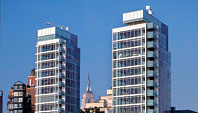
173–176 PERRY STREET, 2002
Richard Meier’s pair of luxury fish tanks facing the Hudson River changed the condo market, the West Village, and the demand for very large, very clear panes of glass. Meier followed with a third tower next door and another on Prospect Park, but not even an authentic knockoff could quite match their supercilious exhibitionism and extravagant austerity. Finally, the city saw an alternative to fetishizing prewar luxury.
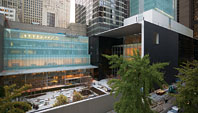
THE ARGUMENT STARTER
MUSEUM OF MODERN ART EXPANSION, 2004
From the day it opened, MoMA’s expansion provoked contradictory reactions, and those feelings have only polarized further. Serene or chilly? Dramatic or corporate? At once domineering and self-effacing, Yoshio Taniguchi’s building encapsulates the evolution of the museum. The term “modern” now describes the past, and Taniguchi’s glossy black-and-white wrapper for MoMA’s older buildings is both beautifully executed historicism and a mummification.
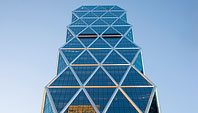
HEARST TOWER, 2006
Punching through Joseph Urban’s showy 1928 International Magazine Building, bedecked with urns, masks, and medieval buskers, Norman Foster’s tower looks stoic. But it offers razzmatazz of its own. Its edges are scalloped, its corner windows tilted. The slanted external beams glow orange at sunset, like swords in a fire. A show-off skyscraper for a town that needs more of them.
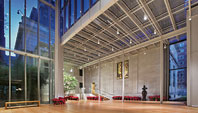
MORGAN LIBRARY EXPANSION, 2006
Stitching together three New York idioms—a glum Victorian brownstone, J. P. Morgan’s Gilded Age palazzo, and his son’s austere Annex—was a surgical challenge that brought out the best in Renzo Piano. The connective tissue of glass, painted steel, and warm glowing wood is best appreciated from the welcoming atrium, which leads to the library’s gothic nooks. The most dramatic feature is invisible: a deep vault that addressed the storage problem that all New Yorkers seem to share.
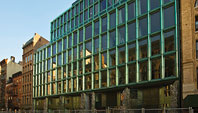
40 BOND STREET, 2007
Even in a pin-striped city, flamboyance has its place, and one of those places is the showy façade of Herzog & de Meuron’s 40 Bond Street. Thick cast-glass tubes frame the huge windows, and a gate as white as a picket fence and as baroquely ornate as a Spanish-cathedral grille separates insiders from hoi polloi. The gate’s graffiti-inspired curlicues proliferate on greenish stainless-steel walls and run into the lobby and up the undulating Corian walls to the mirrored ceiling.
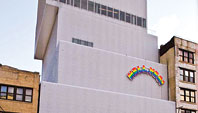
NEW MUSEUM FOR CONTEMPORARY ART, 2008
The Bowery’s first museum (if you don’t count some of the self-embalmed exhibits who used to shamble down the street) is a tough but ghostly presence. SANAA’s stack of boxes with a steel mesh carapace brings a feeling of permanence but not stability to a neighborhood that keeps changing every day. Already, it looks prepared to play a future role as an old-timer on a rejuvenated block.
